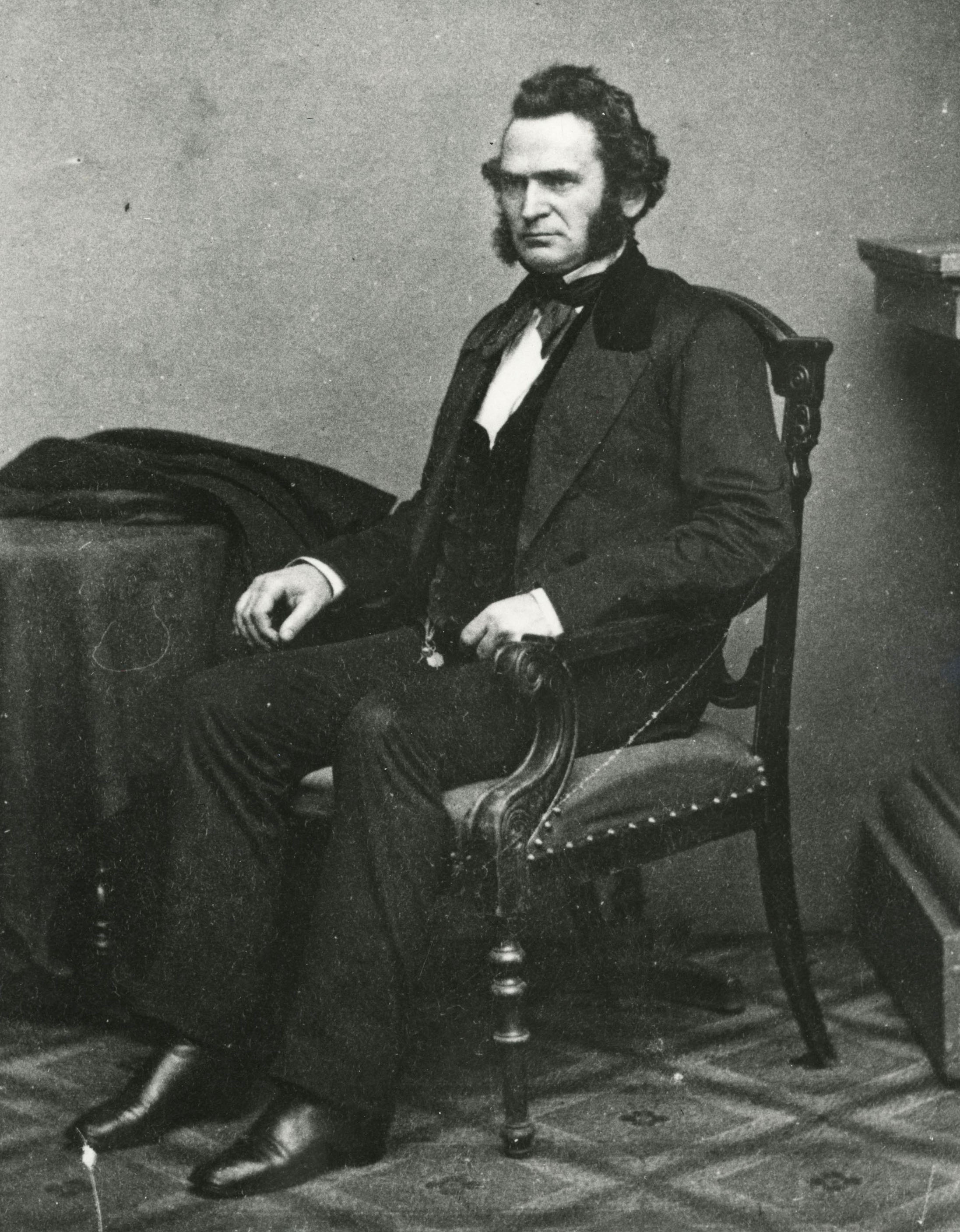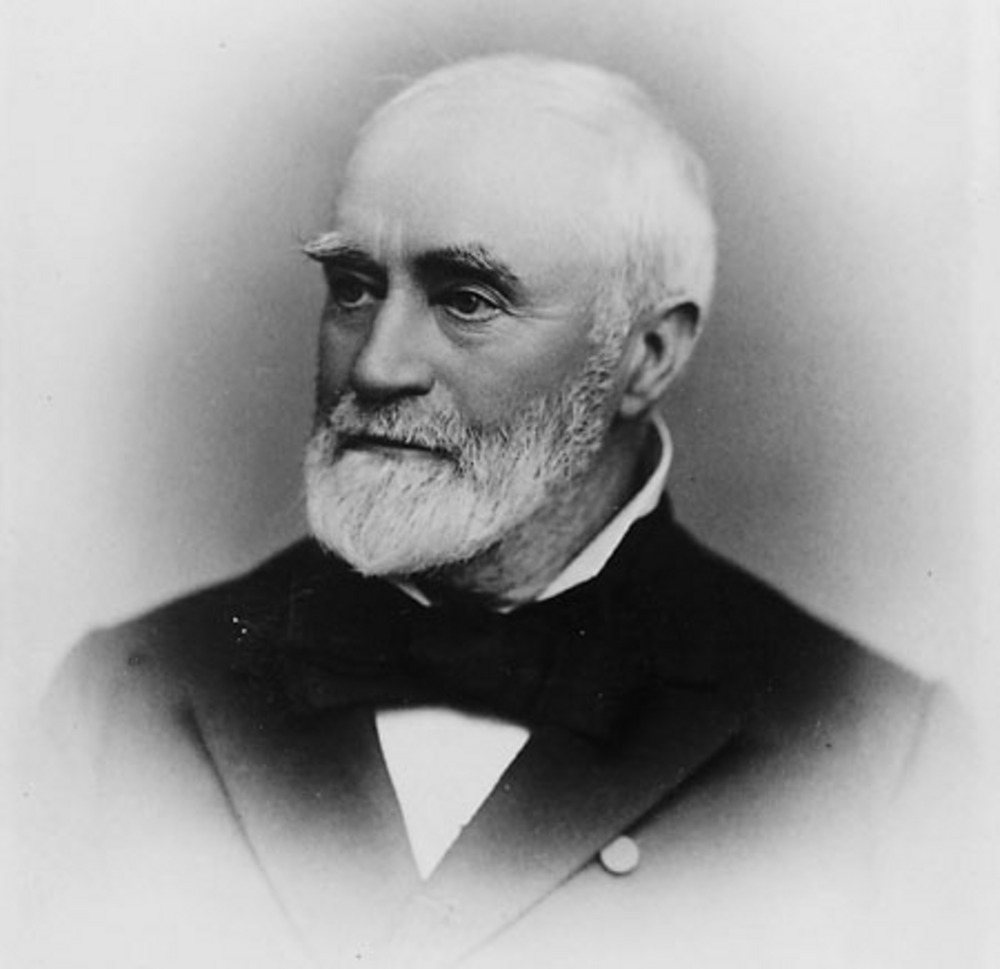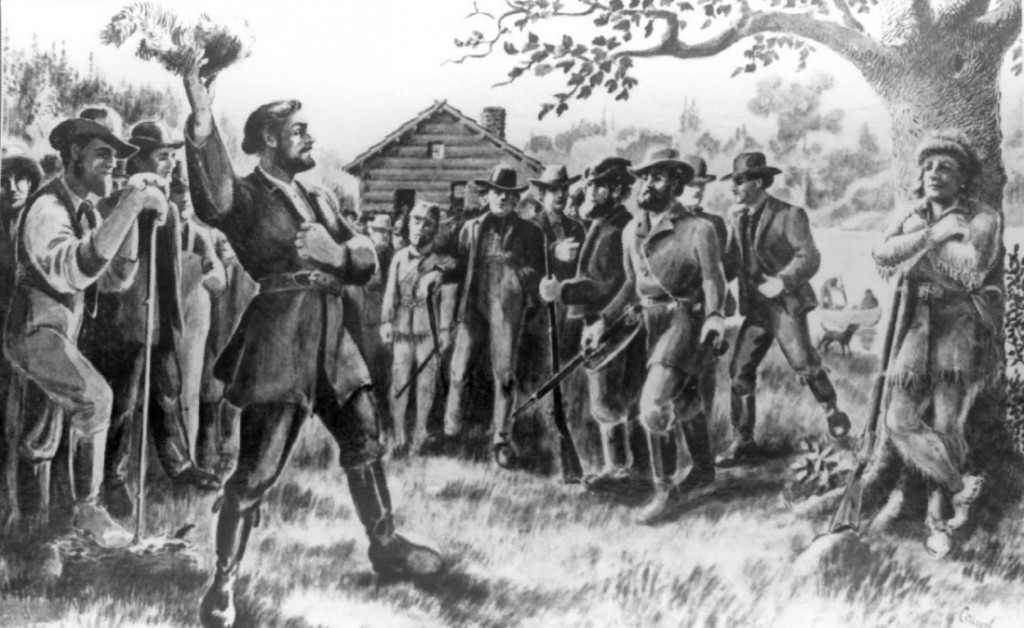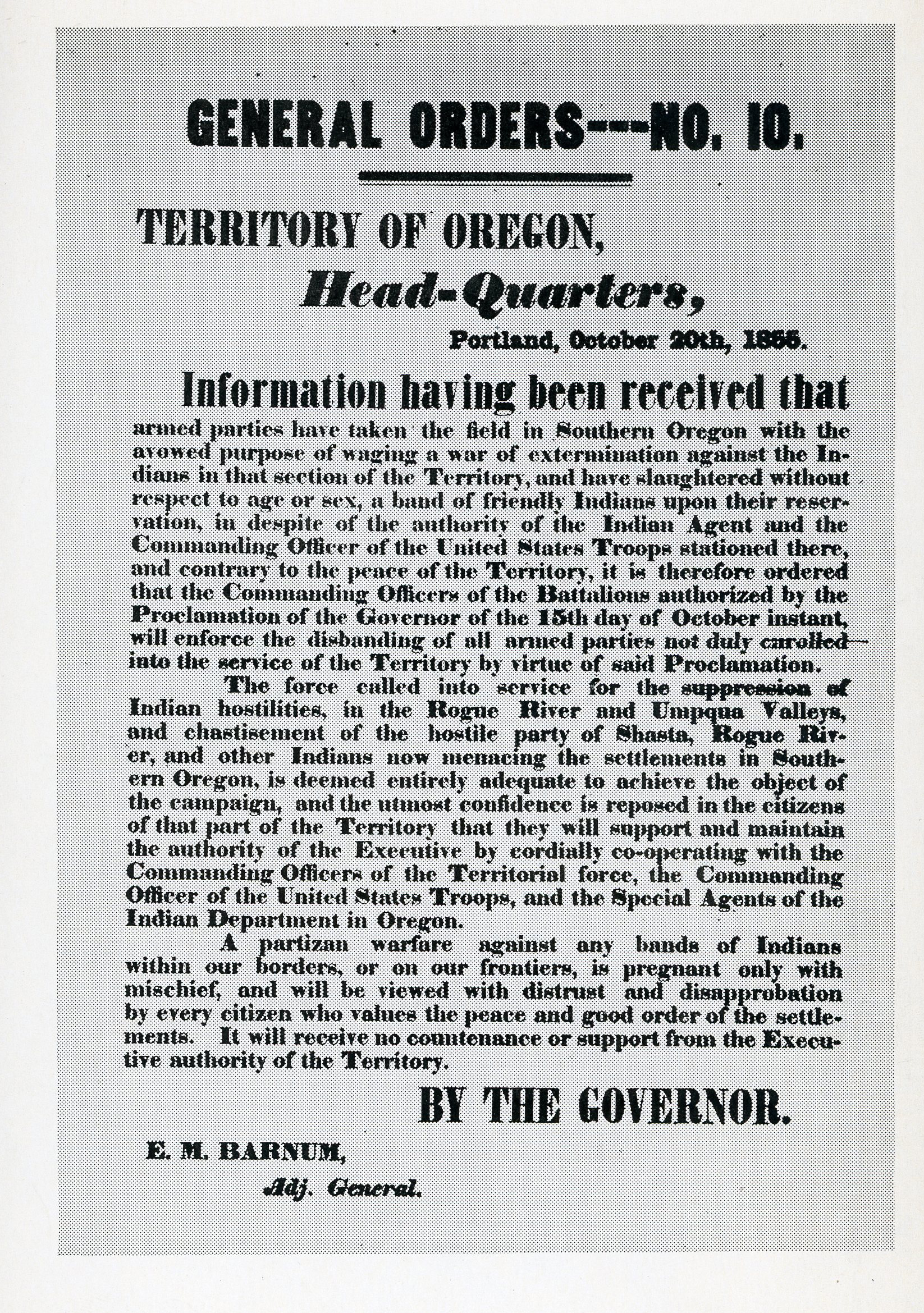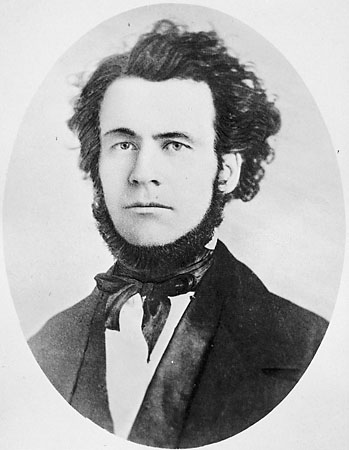James Nesmith was a prominent figure in the Oregon Territory and in Oregon after statehood. He was a member of the volunteer militia during the Indian Wars and a judge for the Provisional Government. He also was a delegate to the Oregon Constitutional Convention and represented Oregon in the U.S. Senate and the U.S. House of Representatives.
Nesmith was born in New Brunswick, Canada, in 1820 when his family was visiting the area from their home in Washington County, Maine. After his mother’s death and his father’s loss of timber holdings and a lumber mill in a fire, he moved with his father, William Morrison Nesmith, to New Hampshire. In middle age, James Nesmith remembered that he had gone to school only briefly but that he had continued to educate himself: “I have a habit of reading and informing myself, and I believe I have now the best library in the State.” As a teenager, he moved to Ohio and Missouri and then to Kansas, where he worked as a carpenter.
In 1843, Nesmith joined the Applegate party, which emigrated to Oregon over the Oregon Trail as part of the Great Migration. En route, he observed and then participated in imaginary cases argued by lawyers in the group and decided to pursue a legal career himself. The lawyers encouraged his interest and aided his legal studies after they reached Oregon. Two years later, he was selected to be a judge in the Provisional Government. He married Lucinda Goff in 1846, who had traveled the Oregon Trail with her family in 1844. In 1848, the discovery of gold drew Nesmith to California, where his success in the mines provided a sizable fortune. The next year, he returned to Lucinda and their children in Polk County, where he farmed, raised cattle, and ran a flour mill.
Nesmith played a key leadership role in Oregon's Indian Wars. He led troops during the 1848 Cayuse War, the 1853 Rogue River War, and the 1855 Yakama War. Near the end of the Rogue River War, he joined Joseph Lane, the territorial delegate to Congress, and other leaders in negotiating a Treaty of Peace with the Takelma. With Lane’s support, President Franklin Pierce appointed Nesmith U.S. marshal responsible for the protection of the settlers. In 1857, again at Lane’s initiative, he was appointed superintendent of Indian Affairs in the Oregon and Washington Territories. His attitude toward Natives is evident in his observation to the commissioner of Indian Affairs that he could “see no way that the settlers can rid themselves of the nuisance, unless they can hit upon some mode for their extermination, a result which would occasion no regrets at this office.”
In 1851, Nesmith met Asahel Bush, the editor of the newly established Oregon Statesman, and was soon a member of what was known as the Salem Clique, a group of young men who dominated Oregon politics during the 1850s. A key goal of the Clique was the organization of the Democratic Party in Oregon Territory. Although Nesmith was reluctant, citing his lack of experience, he was chosen to chair the central committee.
Throughout the 1850s, Oregon politics reflected the national divisions between pro-slavery and anti-slavery factions, and the issue delayed Oregon statehood until 1859. The 1860 presidential campaign saw a breakup of the national Democratic Party, with the northern side nominating Stephen A. Douglas of Illinois and the southern side nominating Vice-President John C. Breckinridge of Kentucky, with Joseph Lane as his running mate. When the new state legislature met in 1860 to fill senatorial seats left empty by Delazon Smith and a retiring Joseph Lane, the Douglas Democrats partnered with the Republicans to elect Nesmith and Republican Edward Dickinson Baker, a friend of Lincoln’s. Baker was killed fighting for the Union in 1861; Nesmith served in the Senate until 1867.
The election of Abraham Lincoln as U.S. president was followed by the secession of the Southern states and the Civil War. Historians have credited Nesmith, along with Asahel Bush, with keeping Oregon in the Union. Through the war, Nesmith was a member of the Senate Committee for Military Affairs. After the war ended, he was widely criticized for his support of President Andrew Johnson’s efforts to put the country back together, which many found overly conciliatory. Perhaps as a result, Nesmith did not win a second term in the Senate. When President Johnson nominated Nesmith as ambassador to Austria, the Senate committee refused to confirm the appointment, an outcome fostered by the sitting senator from Oregon, George H. Williams.
Nesmith returned to Oregon, where he played a substantial role in the Democratic Party. In 1873, he was chosen to serve out the House of Representatives term of his nephew, Joseph G. Wilson, who died before taking office. During his time in Washington, D.C., Nesmith got a certain revenge on Williams by helping to persuade the Senate Judiciary Committee to argue against his confirmation as chief justice of the Supreme Court. Lafayette Grover, then governor of Oregon, congratulated Nesmith on his accomplishment: “We are all glad to get rid of Williams in this State as a politician but don’t think he is fit for the place occupied by Marshall, Taney and Chase.”
When his legislative term ended in 1875, Nesmith returned to his farm in Polk County. He died in 1885 at his home in Rickreall. In 1899, Harrison Rittenhouse Kincaid, Oregon secretary of state, published The Political and Official History and Register of Oregon, which included short biographies of significant figures. Of Nesmith he wrote: “He was witty, genial, brilliant and able, and perhaps wielded more influence and made a deeper impression of the affairs of the new territory and state than any other of the many remarkable who composed the early settlers of Oregon.”
-
![]()
James Nesmith.
Courtesy Oregon Hist. Soc. Research Lib., 67445, photo file 797b
-
![]()
James Nesmith.
Courtesy Oregon Hist. Soc. Research Lib., 12774, photo file 797b
-
![]()
James Nesmith, 1903.
Courtesy Oregon Hist. Soc. Research Lib., Orhi3496, photo file 797b
-
![]()
Lucinda Goff Nesmith, c.1861.
Courtesy Oregon Hist. Soc. Research Lib., 019582
-
![]()
The Nesmith house in Rickreall, Oregon, 1934 (built in 1850).
Courtesy Oregon Hist. Soc. Research Lib., Journal, 006742
-
![]()
James Nesmith's Oregon Trail diary, 1843.
Courtesy Oregon Hist. Soc. Research Lib., Mss577-1, box 4, folder 4
-
![]()
James Nesmith's Oregon Trail diary, 1843, interior.
Courtesy Oregon Hist. Soc. Research Lib., Mss577-1, box 4, folder 4
-
![]()
Nesmith's notebook during the Yakima War, c.1855, listing members of the 1st Regiment Oregon Riflemen.
Courtesy Oregon Hist. Soc. Research Lib., Mss577 box 3, folder 14
-
![]()
Nesmith's appointment to Superintendent of Indian Affairs, 1857, signed by Pres. Buchanan.
Courtesy Oregon Hist. Soc. Research Lib., Mss577, OS C2, folder 1
-
![]()
Millstones from Nesmith's Dallas Flour Mill, built in 1847; stone owl carved by Native people sits on top.
Courtesy Oregon Hist. Soc. Research Lib., 020989
Related Entries
-
![Asahel Bush (1824-1913)]()
Asahel Bush (1824-1913)
Asahel Bush was a key figure during Oregon's formative years, using the…
-
![Edward Baker (1811-1861)]()
Edward Baker (1811-1861)
Edward "Ned" D. Baker, who was born in London, England, on February 24,…
-
![Joseph Lane (1801-1881)]()
Joseph Lane (1801-1881)
Joseph Lane was the first governor of Oregon Territory. A leading Democ…
-
![Matthew Deady (1824-1893)]()
Matthew Deady (1824-1893)
Matthew Paul Deady was a lawyer, politician, and judge in the Oregon Te…
-
![Provisional Government]()
Provisional Government
The Provisional Government, created in May-July 1843, was the first gov…
-
![Rogue River War of 1855-1856]()
Rogue River War of 1855-1856
The final Rogue River War began early on the morning of October 8, 1855…
-
![Salem Clique]()
Salem Clique
Thomas Dryer, the first editor of the Oregonian, named the Salem Clique…
Related Historical Records
Map This on the Oregon History WayFinder
The Oregon History Wayfinder is an interactive map that identifies significant places, people, and events in Oregon history.
Further Reading
"Campfire Orations," with J.W. Nesmith. Hubert Howe Bancroft Papers [microform], 1837-1886. Microfilm 176. Oregon Historical Society Research Library, Portland.
Robbins, William. Landscapes of Conflict. Seattle: University of Washington Press, 2004.
Woodward, Walter Carlton.The Rise and Early History of Political Parties in Oregon, 1843-1868. Portland, Ore.: J.K. Gill, 1913.
Whaley, Gray. Oregon and the Collapse of the Illahee: U.S. Empire and the transformation of an indigenous world, 1792-1859. Chapel Hill: University of North Carolina Press, 2010.


